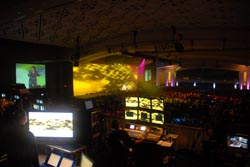Early Adopters

- CPR provided support for the Human Rights Campaign National Dinner at the Washington D.C. Convention Center in November 2006. While there are a lot of rental & staging companies that prefer not to be the first to delve into a new technology, CPR Multimedia has made a name for itself doing just that. From being the first company in the U.S. to take delivery for the Barco 5000, to being the first company to offer Dynascan LED towers, CPR continues to forge new ground for the industry.
- The company started in 1988, when Jeff Studley, now president of CPR, left the restaurant business in New York and came to Gaithersburg, MD to join his cousin, who was in the high tech AV solutions business as general manager of Meyer-Emco, a big AV retailer in Maryland. Studley's cousin had seen the first rumblings of the data revolution and called his cousin in New York to tell him. Studley explained, "He called me and said this is something we ought to get in on, it's the ground floor. At the time that meant Electrohome 56 and 58 monochrome CRT projectors EDP58XL. And we started to buy them to rent to people. That quickly became a very booming business, especially in the DC area because of the federal agents and their contractors. We did work with a lot of little companies then that are big now, like Apollo, Silicon Graphics, Sun, and, Apple."
- After some time, it became apparent that CPR could do more for its customers, as Studley recalled. "As we were doing data display, people were asking us about more. We went to a Silicon Graphics event that we were supporting, and one of the sales people mentioned a videotape they wanted to play. So we swung by a store and picked up a VCR, and that's how we got into non-data display presentation. We had to buy audio to support that, but we kept doing data display and did HD TV as early as 1989 when only CRT projectors could do it. We became known as a specialty projection company, all while adding other services that our clients wanted, like cameras and lighting."
CPR provided video & audio at NACO in Richmond Va. in the Richmond Convention Center, July 2007.
CPR later forged into other aspects of the AV world. Studley said, "We were always trying to be more in control of the job and the parameters that made projection and our portion of the job go well. We tried to do turnkey support so we could ensure the quality of the job, and that's where we are today. We flirted with systems integration for a few years and then I bought my partner out in 2000 and he continued with systems integration as we left it, devoting ourselves to rental and staging."
CPR's dedication to be the first to use a technology has continuously put them on the map for certain gear. Studley explained, "I've always liked to play on the bleeding edge of high resolution, offering graphic projectors, HD projectors, and high resolution LED early on. We're always the early adopters most technologies. A lot of the time people think we're crazy. As a smaller regional company, we've always tried to serve the early adapter market base, and that's why we've found success. We don't do standard AV, we do high end staging and projection."

The ConnectLive Booth at the 2007 GVExpo at the Convention Center in Washington D.C. HDTV Plasmas & Dynascans were installed by CPR.
While this has helped CPR's business greatly, at times it can be a bit overwhelming with the large breadth of event types it encounters. Studley said, "On any given week, we're differentiated by the fact that we're so multifaceted. We might be doing support for the US air force band at Constitution Hall, then we might be doing a video shoot at Discovery Communications for a Discovery Channel show that night, and then we'll be doing 20 HD plasmas monitors at the GV expo for a company called Connect Live, which is all about federal webcasting and info distribution. We're fully defined by the fact that we're not playing in just one niche."
Working in the federal market so often requires CPR to work a bit differently when trying to get shows. Studley explained, "The government requires that we know a lot about how to bid because it's a RFP environment. It's very different than the commercial market, where you can negotiate and talk price with the client to get the best ends for their dollar. So we have to adjust a lot to certain situations and we have sales people who tend to do specific markets."
What makes CPR such a strong company is its willingness to put itself out there for the good of technology, as Studley said, "We still, even after almost 20 years, take our biggest claim as early adopters. We want to be the first guys in town to have everything. We pride ourselves being the state of the art of the industry." For more information visit www.cprmms.com.
A daily selection of the top stories for AV integrators, resellers and consultants. Sign up below.
